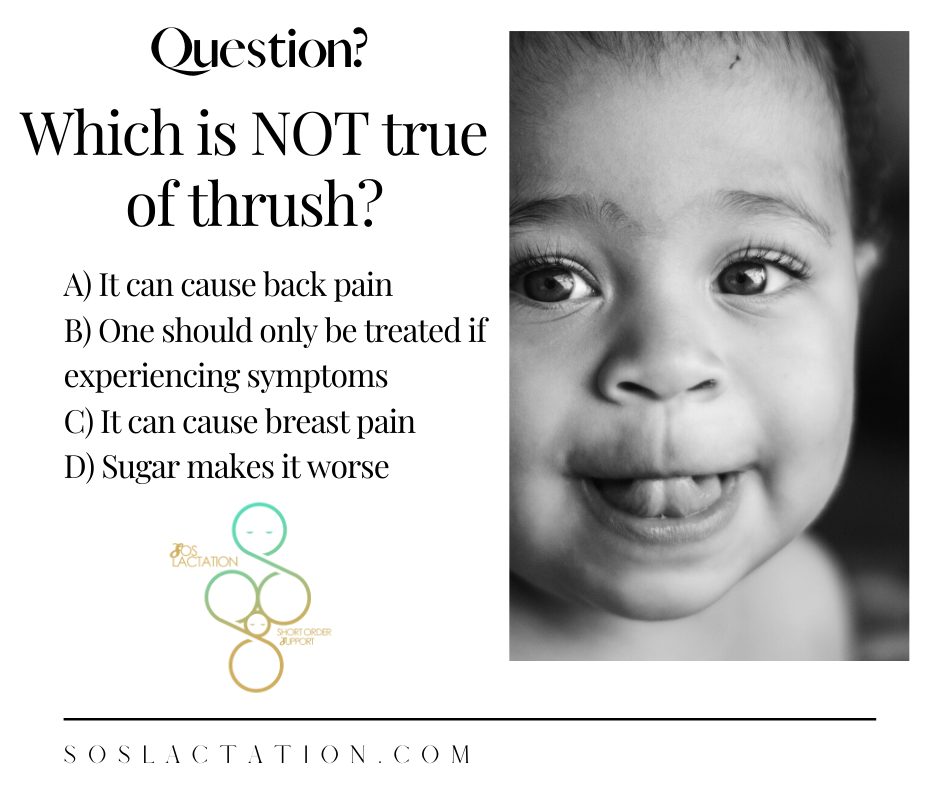The answer is B: Mother and baby should be treated even if either the mother or baby do not have symptoms.
Candida is in all our bodies. It likes warmth and moisture. Candida is fine when our systems are balanced, but an overgrowth can cause breast pain, yeast infections, diaper rash, sore mouth, and a sore throat. Thrush is a fungal infection caused by an overgrowth of candida. Thrush can be tricky, but when properly identified and treated women and babies can experience improvement quickly! Here are the most common mistakes I see new parents make in relation to thrush.
Misdiagnoses
When a baby is latched deeply, the nipple reaches the very back of the soft palate, moving freely without rubbing or pinching. A poor latch leads to varying degrees of nipple damage, typically anything from redness and tenderness, to scabbing, bruising, cracks and abrasions. Usually this pain is present while the baby is breastfeeding. Mothers usually get relief when the baby is not feeding, but not always. A poor latch can also cause shooting pain that radiates in the breast and/or nipple after breastfeeding sessions with little or no discomfort during the feed. This breast and nipple pain after feeds, usually accompanied with a white residue on the baby’s tongue, can easily lead to a misdiagnosis of thrush. Thrush is known for causing sharp shooting pains in-between breastfeeding sessions. When present in baby’s mouth it looks like white patches of milk on the tongue, palate and/or cheeks. Many mothers begin extensive thrush treatment plans when they really have a latching problem.
Here’s how to tell: If your baby appears to have thrush in their mouth take a piece of gauze or cloth and wipe the baby’s tongue. If the white residue comes off, it was milk. If the residue stays on the tongue, begins to bleed, or irritate the baby: It’s likely thrush. If a baby does not have good tongue elevation it can result in milk buildup on the tongue. Poor tongue movement can also cause a painful latch. If you follow a thrush protocol for 3-4 days with little to no improvement, it’s likely you don’t have thrush, or it is not being treated properly.
Antibiotics…but No Probiotic
1-in-3 women get antibiotics during birth. Antibiotics are great at preventing and treating infections. However, along with all the bad bacteria, they also kill the good bacteria in the digestive tract the prevent candida overgrowth. A good quality probiotic can help replace some of the good bacteria your gut needs to prevent and treat thrush. Remember to take probiotics in- between antibiotic treatments. If you take them too close together, the antibiotics will kill any good bacteria from the probiotic. I recommend mothers take them at different parts of the day with a bare minimum of 2 hours in-between.
Not Treating the Dyad
Many times, the baby is treated for thrush by the pediatrician with no treatment for the mother. Or the mother may receive care from her doctor with no treatment for the baby. It is possible for mother or baby to be asymptomatic, but even if one does not have symptoms you can pass it back and forth from one another. Mother and baby should always be treated simultaneously.
A Sugar Filled Diet
I had a client in the past that had a treacherous case of thrush causing her and the baby a lot of pain and sleepless nights. She consumed a lot of sugar and alcohol. She jokingly told me “My occasional beer is the only thing getting me through.” When tired and upset many of us reach for sugar to give us that temporary boost of energy and comfort. Unfortunately, the sugar feeds the yeast that can keep a bad case of thrush thriving. Good gut health from a balanced, nutritious diet is one of the best measures to take to prevent and treat thrush. Remember, always contact your health care professional if you feel you are experiencing thrush so you can continue to breastfeed strong!

